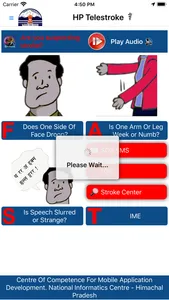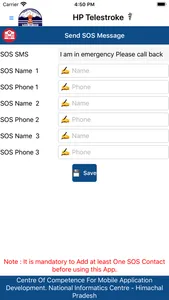Stroke has emerged as a second biggest killer of mankind world over and even in India more people die of stroke than infectious diseases like tuberculosis. Age adjusted stroke prevalence in India ranges from 84 to 424 per 100,000 according to various studies and annual incidence ranges from 105–262/100,000. There is no data available from H.P. but it is estimated from national statistics that H.P. should have 15,000 to 20,000 patients of stroke and every year 5000–10,000 new patients suffer stroke. This number is bound to increase with increased life expectancy and aging of population. After a stroke about 50% patients do not survive beyond 6 months and 25% become dependent for life. So not only mortality but morbidity due to stroke is also overwhelming.
Stroke is of two kinds: one due to rupture of brain blood vessels called hemorrhagic stroke and other is caused by blockage in brain vessels called ischemic stroke. A CT-scan of head can reliably differentiate between the two. Ischemic stroke is much more common and amounts to up to 80% of all strokes. The common symptoms of stroke are sudden appearance of: deviation of face, weakness or numbness of limbs, difficulty in speaking, unsteadiness, giddiness and headache. The simplest way to treat ischemic stroke would be to remove the blockage in brain vessels and now the drugs are available which can dissolve the clot blocking blood vessels. However this drug which is an injection called recombinant tissue plasminogen activator(tPA) can be given within 4.5hrs of onset of stroke symptoms. Therefore it is most important that people recognize stroke symptoms at the earliest and rush to hospital with CT-Scan facility and availability of this drug.
Himachal Pradesh is a small hilly state in the Northern part of India. Covering an area of 55,673 kilometres (34,594 mi), it is a mountainous state. It has a population of 6,856,509 with population density of 123/km2, 90% of which lives in villages as per the provisional results of the Census of India 2011. It has 12 districts with population ranging from 32,000 to 1.5 crore. It has two tertiary care hospitals with four neurologists, two in each hospital. So given the difficult terrain and just four neurologists, delivering stroke treatment seemed like a distant dream.
However in March 2014 under the guidance of Stroke Specialist Prof. M.V. Padma from All India Institute of Medical Sciences, New Delhi and on the initiative of Additional Chief Secretary Health to Govt. of H.P., Sh. Vineet chaudhary a Telestroke Project was envisaged. All the government hospitals with CT-Scan facility were roped in. Out of 17 such hospitals, eight and nine centers respectively were attached to each of the two tertiary care centers. Workshops were conducted at various district hospitals. Medical officers in these hospitals (M.B.B.S. graduates and internal Medicine postgraduates) were trained in recognizing stroke through these workshops. They were taught reading plain CT-scan head to rule out hemorrhage even without the help of radiologist and written protocols for thrombolysis in ischemic stroke with explicit inclusion and exclusion criteria were provided. Blood sugar and ECG were only other investigations to be done apart from CT- head before thrombolysis. Tissue plasminogen activator was made available at all these centres and provided free of cost through hospital pharmacies. All the four neurologists were made available on phone 24x7 and whenever any ischemic stroke came in window period they were to be contacted. It was decided to use social networking sites like “Whatsapp for transmitting CT-scan images to neurologists for consultation. These hospitals were than designated as primary stroke centres. Without any extra infrastructure requirement or any new manpower the project was finally launched in May-June 2014 amid much skepticism about its success.
The app empowers general public with Stroke Awareness and related action in emergency
Stroke is of two kinds: one due to rupture of brain blood vessels called hemorrhagic stroke and other is caused by blockage in brain vessels called ischemic stroke. A CT-scan of head can reliably differentiate between the two. Ischemic stroke is much more common and amounts to up to 80% of all strokes. The common symptoms of stroke are sudden appearance of: deviation of face, weakness or numbness of limbs, difficulty in speaking, unsteadiness, giddiness and headache. The simplest way to treat ischemic stroke would be to remove the blockage in brain vessels and now the drugs are available which can dissolve the clot blocking blood vessels. However this drug which is an injection called recombinant tissue plasminogen activator(tPA) can be given within 4.5hrs of onset of stroke symptoms. Therefore it is most important that people recognize stroke symptoms at the earliest and rush to hospital with CT-Scan facility and availability of this drug.
Himachal Pradesh is a small hilly state in the Northern part of India. Covering an area of 55,673 kilometres (34,594 mi), it is a mountainous state. It has a population of 6,856,509 with population density of 123/km2, 90% of which lives in villages as per the provisional results of the Census of India 2011. It has 12 districts with population ranging from 32,000 to 1.5 crore. It has two tertiary care hospitals with four neurologists, two in each hospital. So given the difficult terrain and just four neurologists, delivering stroke treatment seemed like a distant dream.
However in March 2014 under the guidance of Stroke Specialist Prof. M.V. Padma from All India Institute of Medical Sciences, New Delhi and on the initiative of Additional Chief Secretary Health to Govt. of H.P., Sh. Vineet chaudhary a Telestroke Project was envisaged. All the government hospitals with CT-Scan facility were roped in. Out of 17 such hospitals, eight and nine centers respectively were attached to each of the two tertiary care centers. Workshops were conducted at various district hospitals. Medical officers in these hospitals (M.B.B.S. graduates and internal Medicine postgraduates) were trained in recognizing stroke through these workshops. They were taught reading plain CT-scan head to rule out hemorrhage even without the help of radiologist and written protocols for thrombolysis in ischemic stroke with explicit inclusion and exclusion criteria were provided. Blood sugar and ECG were only other investigations to be done apart from CT- head before thrombolysis. Tissue plasminogen activator was made available at all these centres and provided free of cost through hospital pharmacies. All the four neurologists were made available on phone 24x7 and whenever any ischemic stroke came in window period they were to be contacted. It was decided to use social networking sites like “Whatsapp for transmitting CT-scan images to neurologists for consultation. These hospitals were than designated as primary stroke centres. Without any extra infrastructure requirement or any new manpower the project was finally launched in May-June 2014 amid much skepticism about its success.
The app empowers general public with Stroke Awareness and related action in emergency
Show More



